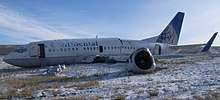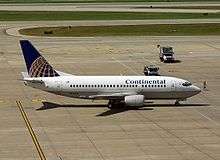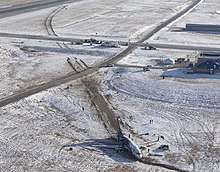Continental Airlines Flight 1404
Continental Airlines Flight 1404 was a Continental Airlines flight from Denver International Airport in Denver, Colorado, United States to George Bush Intercontinental Airport in Houston, Texas.[1] On the evening of December 20, 2008, the flight crashed while taking off from Denver resulting in two critical injuries, 36 non-critical injuries and a hull loss of the Boeing 737-524 aircraft.[1][2]
 Flight 1404 after crash | |
| Accident | |
|---|---|
| Date | December 20, 2008 |
| Summary | Runway excursion due to pilot error in abnormal wind gust that the industry did not train for |
| Site | Denver International Airport, Denver, Colorado 39°52′30″N 104°41′13.24″W |
| Aircraft | |
| Aircraft type | Boeing 737-524 |
| Operator | Continental Airlines |
| Registration | N18611 |
| Flight origin | Denver International Airport, Denver, Colorado |
| Destination | George Bush Intercontinental Airport, Houston, Texas |
| Occupants | 115 |
| Passengers | 110 |
| Crew | 5 |
| Fatalities | 0 |
| Injuries | 38 |
| Survivors | 115 |
Incident

On Saturday, December 20, 2008 at approximately 18:18 (06:18PM) local time, after being cleared for takeoff on runway 34R at Denver International Airport, the Boeing 737-524 aircraft veered off the side of the runway before taxiway WC (less than 4,000 feet (1,200 m) from the threshold), skidded across the taxiway and a service road and crashed in a 40-foot-deep (12 m) ravine several hundred yards from the runway.[2][3] The right engine caught fire and the fire spread to the fuselage.[3][4]
Despite early confusion as to the whereabouts of Flight 1404, firefighters were on scene relatively quickly, as the aircraft came to rest near one of the airport's four fire houses.[3] When they arrived, most of the right side of the plane was on fire while passengers were climbing out of the left side, being assisted by flight attendants[5] and one off-duty Continental Airlines pilot in the cabin, the latter making several trips in and out of the wreckage to ensure everyone was safely out of the aircraft.[6] The off duty pilot, Richard Lowe, was part of the crew which had flown the incident aircraft into Denver; an Air Force reservist, Lowe was awarded the Airman's Medal for his actions.[7]
The aircraft sustained severe damage. The fuselage was cracked just behind the wings, the number 1 engine and main landing gear were sheared off, and the nose gear collapsed.[3] The fire caused overhead luggage compartments to melt onto seats.[8]
The crash is noted as the most serious incident in DIA's history.[9] The aircraft was subsequently written off.[2]
Injuries

Of the 110 passengers and 5 crew on board,[1] 38 sustained injuries including broken bones, though everyone on board survived.[10]:6[11][12] Two passengers and one of the crew were critically injured, though both passengers' conditions were upgraded that evening.[13] By the following morning, fewer than seven people remained hospitalized.[13]
Captain David Butler, 50, was among the critically injured.[14] He was hospitalized with serious back injuries and bone fractures.[15] The first officer, Chad Levang, 34, received minor injuries.
Investigation
The aircraft's black boxes were recovered from the wreckage in usable condition.[16] The cockpit voice recorder did not reveal any apparent problem until 41 seconds after the aircraft's brakes were released, just before takeoff.[17][18] At that point a bumping or rattling sound can be heard, and the crew aborted the takeoff four seconds later. Both recorders stopped working six seconds after that (before the plane came to a stop).[17][18] At one point during the sequence, the plane's speed reached 119 knots (137 mph; 220 km/h).[17][18]
When interviewed, First officer Levang told investigators that he was unaware of any problem until the plane was traveling between 87 and 90 knots (100 and 104 mph; 161 and 167 km/h), when it moved away from the runway's centerline and made a "sudden left turn".[18] He indicated that Captain Butler, who was too badly injured to interview with officials when the investigation began, was flying at the time.[17][18] Both the captain and first officer had clean safety records when the crash occurred and were experienced pilots.[4][18]
Wheel marks left on the ground as well as initial reports from passengers and firefighters indicate that the plane was airborne, briefly.[3][19] It is unclear at which point during the sequence the fire started.[16][19] There was no snow or ice on the runway, however there were 31-knot (36 mph; 57 km/h) crosswinds at the time.[20][21]
The flight crew that flew the aircraft to Denver prior to the incident flight was also on board, though not on duty, and reported having no difficulties with the plane during their previous flight.[17] It suffered an engine failure and subsequent emergency landing in 1995, following which both engines were replaced, but was otherwise undamaged in that incident.[4]
Initial speculation suggested that the plane could have suffered a landing gear malfunction that might have resulted in a wheel lockup during the takeoff roll, leading to the runway excursion.[5][11][14] NTSB officials said that when the takeoff began, the aircraft's engines appeared to be functioning properly, its tires were inflated, and the brakes did not appear as if they had failed or otherwise malfunctioned, concluding that the landing gear did not cause any problems.[17][18]
On July 17, 2009 it was announced that focus had shifted to a possible large gust of wind or a patch of ice. Captain David Butler stated that: "My speculation is that we either got a big, nasty gust of wind or that, with the controls we had in, we hit some ice." He also stated that he stopped pushing on rudder controls because they had stopped working.[22] The winds were reported at about 24 and 27 knots (28 and 31 mph; 44 and 50 km/h) from the northwest with gusts up to nearly 32 knots (37 mph; 59 km/h) just before the airliner began its takeoff roll northward down a north-south runway. The 737 has a crosswind limitation for takeoff of 33 knots (38 mph; 61 km/h) on a dry runway.[23]
Contrary to the "average" wind data reported to the incident pilots, the NTSB investigation found that a sensor at one end of the runway showed a crosswind of 40 knots (46 mph; 74 km/h), with analysis showing the airplane was hit with a peak gust crosswind of 45 knots (52 mph; 83 km/h).[10] in addition to being much higher than the data reported to the pilots as they prepared for takeoff, this was also much higher than the airline industry used in pilot training.[10] The NTSB also received a report analyzing 250,327 departures involving 737-500s, and found that only 4 of those departures (less than 0.002%) had experienced a crosswind above 30 knots (35 mph; 56 km/h),[10] meaning that it was just short of impossible for a commercial pilot to have real-life experience with crosswinds anywhere near the velocity that hit Continental Airlines Flight 1404 that day.[22] The NTSB believes that this is why the pilot believed that his rudder controls were not working, deciding to not push the rudder anymore and to focus instead on other, inadequate remedies to the situation.[22]
On July 13, 2010 the NTSB published that the probable cause of this accident was the captain's cessation of right rudder input, which was needed to maintain directional control of the airplane, about 4 seconds before the excursion, when the airplane encountered a strong and gusty crosswind – with a contributing factor of inadequate crosswind training for extreme wind gusts in the airline industry.[10] A further contributing factor was no requirement for the air traffic control system to provide sufficient wind information to the air traffic controllers and pilots.[10] In response to the NTSB report, the Federal Aviation Administration required the airline industry to adjust the crosswind training protocols for pilots, and required ATC to provide multiple sources of wind information, rather than averages, to pilots.[22]
In popular culture
The crash of Continental Airlines Flight 1404 was covered in "Runway Runoff" a Season 19 (2019) episode of the internationally syndicated Canadian TV documentary series Mayday.[22]
See also
References
- "Continental Airlines Responds to Flight 1404 Accident" Continental Airlines. December 21, 2008. Retrieved on December 20, 2008. Archived February 18, 2012, at the Wayback Machine
- Continental Flight CO1404. Aviation Safety Network. Retrieved on December 21, 2008.
- Boniface, Dan; Wolf, Jeffrey (December 21, 2008). "NTSB begins investigation into why plane slid off runway". KUSA. Archived from the original on December 3, 2012.
- "Cause of Denver plane accident unclear, transportation officials say". Los Angeles Times. December 22, 2008. Retrieved on December 22, 2008.
- Schmollinger, Christian and Cotts, Cynthia. "Continental Flight Skids Off Runway, Injuring Some (Update3)." Bloomberg. December 21, 2008. Retrieved on December 21, 2008.
- Siekert, Airman Alexis (December 10, 2010). "Reservist awarded the Airman's Medal for off-duty heroism". Air Education and Training Command. United States Air Force. Archived from the original on December 19, 2010. Retrieved December 14, 2010.
- Christenson, Sig (December 10, 2010). "Continental pilot awarded heroism medal". San Antonio Express-News. Retrieved January 23, 2017.
- Correll, DeeDee. "Continental flight veers off Denver runway, injures dozens." Los Angeles Times. December 21, 2008. Retrieved on December 21, 2008. Archived January 30, 2009, at the Wayback Machine
- "Plane wreckage could be moved next week". 9NEWS. December 26, 2008. Retrieved on December 26, 2008.
- "Runway Side Excursion During Attempted Takeoff in Strong and Gusty Crosswind Conditions Continental Airlines Flight 1404 Boeing 737‐500, N18611 Denver, Colorado December 20, 2008" (PDF). National Transportation Safety Board. July 13, 2010. NTAB/AAR-10/04. Retrieved March 27, 2015.
- "Brakes eyed in Denver plane crash." MYSA. December 21, 2008. Retrieved on December 22, 2008.
- "Firefighter recalls a miracle on a Denver runway." Associated Press. December 21, 2008. Retrieved on December 21, 2008.
- Wyatt, Kirsten. "Firefighter says it's a 'miracle' no one died in Denver burning jet Archived 2012-02-24 at the Wayback Machine." Associated Press. Sunday December 21, 2008.
- "Source: Landing gear, wheels, brakes possible cause of crash". CNN. December 22, 2008. Retrieved December 22, 2008.
- Pasztor, Andy (December 23, 2008). "Investigators Confirm Continental Jet Crew Tried to Abort Takeoff". Wall Street Journal. Retrieved December 23, 2008.
- "Plane's 'black boxes' recovered". Denver Post. December 21, 2008. Retrieved on December 22, 2008.
- "NTSB: Wheels, brakes didn't cause Continental accident". CNN.com. December 22, 2008. Retrieved December 22, 2008.
- "DIA crash details emerge". The Denver Post. December 23, 2008. Retrieved on December 23, 2008.
- "Aerial video indicates breakup sequence of crashed plane". 9NEWS. December 22, 2008. Retrieved December 22, 2008.
- "Continental Airlines Statement Regarding Flight 1404." Continental Airlines. December 20, 2008. Retrieved on December 21, 2008. Archived February 18, 2012, at the Wayback Machine
- "Continental flight slides off runway; dozens injured". 9NEWS. December 21, 2008. Retrieved December 21, 2008.
- "Runway Runoff". Mayday. Season 19. Episode 7. Cineflix. February 11, 2019. Discovery Channel Canada.
- Lowy, Joan. "Pilot recalls 'massive gust of wind' before crash." USA Today. July 17, 2009. Retrieved on December 29, 2009.